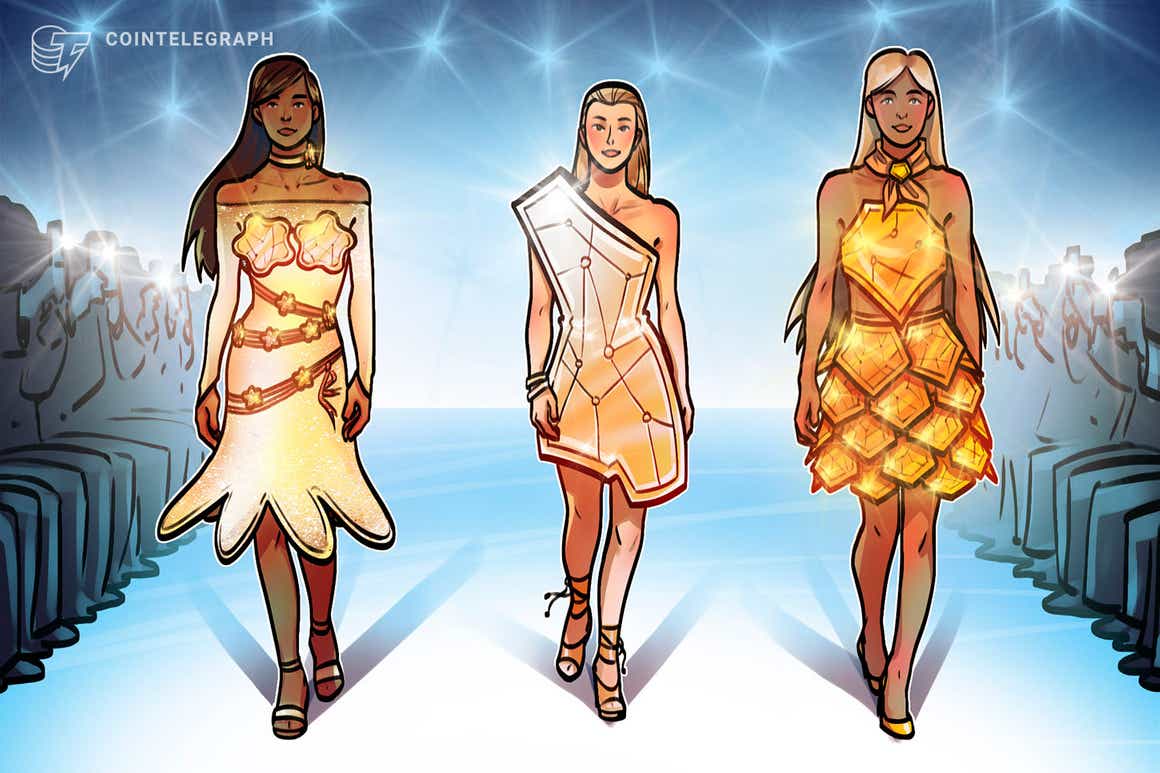The rise of the Metaverse and Web 3.0 are set to disrupt multiple sectors including the billion-dollar global fashion industry. As the world moves
The rise of the Metaverse and Web 3.0 are set to disrupt multiple sectors including the billion-dollar global fashion industry. As the world moves from physical to digital, traditional fashion design can transform into virtual wearables that can be leveraged in both augmented reality (AR) and in real life.
Megan Kaspar, managing director at Magnetic Capital and member of Red DAO — a fashion-focused decentralized autonomous organization — told Cointelegraph she believes that digital fashion nonfungible tokens, or NFTs, will be the largest NFT category of Web 3.0:
“Digital fashion NFTs include clothing, shoes, jewelry, accessories and more that can be worn virtually or within gaming ecosystems. These digital wearables are currently being used for speculative investment and collecting, to clothe avatars in decentralized games, to wear in augmented reality environments and to be superimposed onto photos and videos.”
While Kaspar is aware that digital wearables are being leveraged in decentralized gaming environments today — such as the NFTs utilized in Decentraland — she explained that in the next two years wearable fashion will be more interactive. For instance, Kaspar recently demonstrated how virtual NFT earnings and other accessories can be worn during video interviews.
Wear-to-earn model enters the fashion industry
Kaspar further mentioned that a “wear-to-earn” model will thrive in AR environments, noting that designers, brands and retailers will create clothes to accommodate digital closets. In order to build long-term relationships with consumers, Kaspar noted that designers will pay consumers to wear their virtual items:
“Brands will compensate customers for wearing pieces by giving them access to exclusive items or airdropping fashion pieces to their virtual wallets, or by paying them in the form of a fungible token.”
According to Kaspar, the Italian luxury fashion house Dolce & Gabbana will soon launch “D&G Family,” which is a community-based NFT drop taking place on the UNXD curated marketplace. “This will give consumers access to exclusive physical apparel only available through the drop,” she said. Dolce & Gabbana recently launched their “Collezione Genesi” NFT collection to underscore the power of metaverse wearables.
Related: Culture converges with blockchain as luxury fashion brands launch NFT collections
While Kaspar anticipates seeing UNXD as the first luxury platform to offer wear-to-earn features, other NFT ecosystems have started to adopt the concept. For example, Davaproject – an NFT project from the startup studio Unopnd – is currently building a system of avatar NFTs that reflect changes in various combinations on a blockchain network. A recent announcement claims that the project will initially consist of 10,000 avatar NFTs called “Dava,” which will be minted with 30,000 wearable items. Davaproject will set the rarity of each wearable, showing different rankings across a user dashboard. Owners will then receive benefits such as invites to community events, NFT airdrops, giveaways and new item drops by wearing these items.
Given the rise of virtual wearables, Norman Tan, editor in chief at Vogue Singapore, told Cointelegraph that he is bullish on digital fashion. Tan recently published Vogue Singapore’s September issue, which demonstrated the theme of “New Beginnings.” The September issue featured a unique print cover in the form of a QR code serving as a portal to two digital-only NFT covers. Tan said:
“Fashion and innovation has always been at the heart of what we do at Vogue Singapore. With the global September issue theme of ‘New Beginnings,’ we took the bold step to venture into the metaverse — the destination for a new class of digital artists and designers.”
Not only will digital fashion disrupt the Metaverse, Tan added that virtual wearables will help alleviate sustainability issues by introducing a post-waste economy. According to Kaspar, 40% of western closets go unworn, noting that digital clothes can be an eco-friendly replacement for physical items.

Additionally, virtual fashion shows are proving to be more sustainable and accessible. For example, NFT Runway — a company democratizing fashion by enabling brands to deploy in sustainable ways — is hosting a digital fashion show on Dec. 3-5 during “Fashion Community Week San Francisco.” The interactive fashion show will be broadcast live in the Metaverse with NFT versions of physical items recreated using patented 3DREALTM technology. This will allow audience participants to virtually “hop on” the runway to view each item while twisting their avatar around to view the clothing from any angle.
Oh Tepmongkol, chief operating officer of Ohzone, Inc — the company behind Ohzone’s 3DREALTM interactive technology — told Cointelegraph that it makes sense for both virtual and real-world fashion shows to incorporate NFTs:
“They are tokens…
cointelegraph.com
